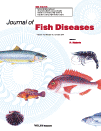Heart rate as an indicator of stress during the critical swimming speed test of farmed Atlantic salmon (Salmo salar L.)

Abstract
Swim tunnel is to fish as treadmill to humans and is a device used for indirect measuring of the metabolic rate. This study aims to explore the fish stress (if any) during the critical swimming test routines (fish handling, confinement and swimming) using heart rate (fH, heartbeat per minute) bio-loggers in farmed Atlantic salmon (Salmo salar L.). In addition, the recovery dynamics of exercised fish using fH were explored for 48 h post-swim tests. Continuous fH data were acquired following the surgical implantation and throughout the trials, such as during fish handling, swim tests (critical swimming speed, Ucrit) and 48 h post-swim tests. Upon 3 weeks of surgical recovery, fH stabilized at 46.20 ± 1.26 beats min−1, equalizing a ca. 38% reduction in fH recorded post-surgical tachycardia (74.13 ± 1.44 beats min−1). Interestingly, fH elevated by ca. 200% compared to baseline levels not only due to the Ucrit (92.04 ± 0.23 beats min−1) but also due to fish handling and confinement in the swim tunnel which was 66% above the baseline levels (77.48 ± 0.34 beats min−1), suggesting fish stress. Moreover, significantly higher plasma cortisol levels (199.56 ± 77.17 ng mL−1) corresponding to ca. 300% increase compared to baseline levels (47.92 ± 27.70 ng mL−1) were identified after Ucrit, predicting the post-swim test stress (physiological exhaustion). These findings reinforce the importance of fish acclimation in the swim tunnel prior to the swimming tests. However, fH dropped over the course of 48 h post-swim test, although remained comparatively higher than the basal levels, suggesting fish should be given at least 48 h to recover from handling stress for better fish welfare. This study further explored the influence of fish tagging on Ucrit which resulted in reduced swimming capabilities of tagged fish (1.95 ± 0.37 body lengths s−1) compared to un-tagged fish (2.54 ± 0.42 body length s−1), although non-significant (P = 0.06), and therefore, future tagging studies are warranted.
